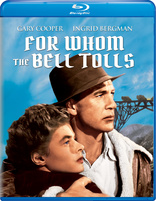For Whom the Bell Tolls Blu-ray Movie
HomeFor Whom the Bell Tolls Blu-ray Movie 
Universal Studios | 1943 | 157 min | Not rated | Apr 17, 2018Movie rating
6.7 | / 10 |
Blu-ray rating
| Users | 0.0 | |
| Reviewer | 1.5 | |
| Overall | 1.5 |
Overview
For Whom the Bell Tolls (1943)
During the Spanish Civil War, an American allied with the Republicans finds romance during a desperate mission to blow up a strategically important bridge
Starring: Gary Cooper, Ingrid Bergman, Akim Tamiroff, Arturo de Córdova, Vladimir SokoloffDirector: Sam Wood (I)
| Romance | Uncertain |
| War | Uncertain |
| Drama | Uncertain |
| History | Uncertain |
| Adventure | Uncertain |
Specifications
Video
Video codec: MPEG-4 AVC
Video resolution: 1080p
Aspect ratio: 1.36:1
Original aspect ratio: 1.37:1
Audio
English: DTS-HD Master Audio 2.0 Mono (48kHz, 24-bit)
Subtitles
English SDH
Discs
Blu-ray Disc
Single disc (1 BD)
Playback
Region A (B, C untested)
Review
Rating summary
| Movie | 3.5 | |
| Video | 1.0 | |
| Audio | 4.0 | |
| Extras | 0.0 | |
| Overall | 1.5 |
For Whom the Bell Tolls Blu-ray Movie Review
It Tolls for this Botched Blu-ray
Reviewed by Michael Reuben May 15, 2018If imitation is the sincerest form of flattery, then the Warner Archive Collection should be deeply
gratified by Universal Studios' current effort to replicate WAC's successful business model for
releasing catalog titles on Blu-ray. WAC has figured out how to make a profit on discs that will
not sell in the tens of thousands, because, among other reasons, brick-and-mortar chains like
Target and Wal-Mart won't stock them. Attempting to follow WAC's example, Universal has
begun issuing select films from their vault on Blu-ray, pressing discs in limited quantities and
offering them strictly through e-tailers like Amazon and BestBuy.com. They're even using the
same distribution house, in the apparent belief that the distributor is somehow the "secret sauce"
in WAC's success. (It isn't.)
But Universal has a lot to learn, starting with the sheer mechanics of getting discs out the door. It
scheduled ten catalog releases for April 17, almost none of which were available on street date.
Back orders at Amazon and Best Buy have taken weeks to fulfill. Many prospective purchasers
are still waiting. And, unlike WAC, Universal does not supply screeners, so that there are no
early reviews to stimulate interest and drive sales.
Having flunked the first test for releasing catalog Blu-rays, which is the simple task of providing
product to consumers, how is Universal doing with the product itself? The studio's past handling
of catalog titles was erratic at best, and the situation hasn't improved with their latest push, which
includes the 1943 filmed adaptation of Ernest Hemingway's classic novel, For Whom the Bell
Tolls. Although the film was originally produced by Paramount, it is now part of Universal's
library, and it should be treated as one of the jewels in the studio's collection. Consistent with
its A-list literary pedigree, the production was a lavish Technicolor affair that was initially
released in an expansive "roadshow" presentation of the kind that studios used to accord their
prestige pictures. It was nominated for nine Oscars, winning one for supporting actress Katina
Paxinou. (It lost Best Picture to another war time adventure, Casablanca.) Trimmed by 40
minutes for general release, the film was restored in the Nineties to as close to its original
running time as Universal could manage (approximately four minutes of cut footage could not be
found).
But Universal's Blu-ray of Bell Tolls provides far less than the DVD released in 1998. For one
thing, the studio has not used the fully restored roadshow presentation. The Blu-ray's actual
running time is nine minutes shorter than the listed length of 2:46, because the overture and
intermission have been cut. The DVD extras, though relatively limited, have been omitted. And
while the video master reflects some effort by the studio to address the many flaws in its analog
restoration done over twenty years ago, far too many artifacts remain, and some new ones have
been introduced. (For further discussion, please refer to the "Video" section below.)
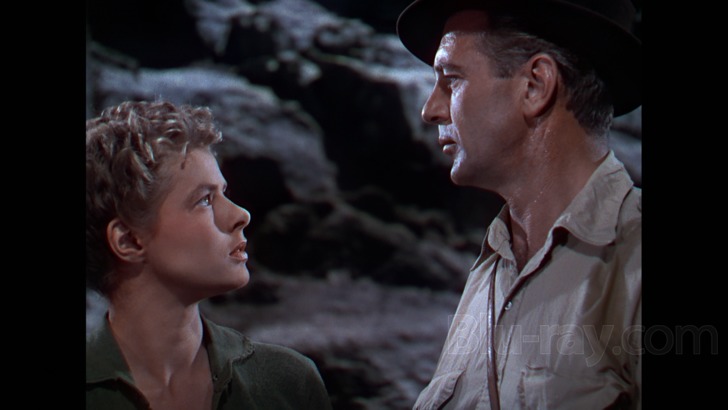
For Whom the Bell Tolls is set in Spain in 1937, during the civil war between the so-called Popular Front or "Republican" government and the fascist a/k/a "Nationalist" forces commanded by General Franco. Hemingway was intimately familiar with the conflict from his experience as a war correspondent in Madrid, which was the subject of the recent HBO bio-pic, Hemingway & Gellhorn. The story concerns an American, Robert Jordan, a teacher turned volunteer soldier, who joins the Republican forces for much the same reasons that Rick Blaine in Casablanca always ends up on the side of the underdog. Hemingway undoubtedly based much of the character on himself, but he also reportedly had Gary Cooper in mind when writing the novel. The author retained enough casting approval when he sold the movie rights to ensure that Cooper would play Jordan.
Jordan is sent into a mountainous region behind enemy lines with orders to dynamite a bridge in support of a planned Republican assault. As in the novel, much of the film concerns Jordan's interactions with the loosely affiliated bands of irregulars with which he must coordinate his efforts. Chief among them are the guerillas led by Pablo (Akim Tamiroff), who was once a fierce fighter but now spends his days in a drunken stupor, convinced that the Republican cause is lost. When Pablo refuses to assist Jordan, he is pushed aside by his wife, Pilar (Paxinou), a resolute peasant woman who is the most memorable character in both the novel and the film. A unique mixture of practicality and superstition, Pilar remains committed to the fight her husband has abandoned, and her fearless determination rallies the dejected freedom fighters to support Jordan's mission, despite numerous obstacles and repeated setbacks, including sabotage by Pablo himself.
Hiding in the mountains with the guerillas is a refugee named Maria (Ingrid Bergman), a survivor of a village raided by Nationalist forces, who was repeatedly raped after her parents were shot dead in front of her. Maria now lives under Pilar's protection, like a wounded animal being nursed back to health. The sweet fragility of love during wartime is a recurrent theme in Hemingway, and the passion that sparks between Jordan and Maria is one of the most famous examples. The author's description of their sexual encounter has spawned countless wisecracks about whether "the earth moved", and although the era's Production Code did not permit director Sam Wood (The Pride of the Yankees) to show much beyond hugs and kisses, the onscreen chemistry between Bergman and Cooper was powerful enough to convey the intensity of their characters' attraction. (They're aided by the reaction of Pilar, whose ability to read people is unerring.)
Hemingway wrote Bell Tolls in a distinctive style that repeatedly incorporated literal translations of the Spanish in which the characters are speaking, including distinguishing between formal and informal second-person pronouns by using "thee" and "thou". These locutions are a constant reminder of Jordan's status as an outsider, and his foreign perspective is critical to the novel's exploration of the politics underlying the war. But by the time the film was released in 1943, Franco's forces had prevailed, and Spain was officially a neutral party in a world war to which the U.S. was now fully committed. Reportedly under diplomatic pressure, Paramount decreed that Dudley Nichols' (Stagecoach) script downplay the politics, with the result that all references to Franco disappeared, and fascism is mentioned only in connection with Hitler and Mussolini. Jordan explains his interest in the Spanish conflict in a short speech in which he declares Spain to be a "proving ground" for Germany and Italy—a motivation that no doubt seemed perfectly reasonable to audiences in 1943 but had the unfortunate effect of glossing over specifics of the Spanish conflict that were essential to the moral examination in Hemingway's tale. (Some of this survives, e.g., in Pilar's gripping account of the Republican takeover of her village.)
Once Jordan is firmly embedded with the guerillas, Bell Tolls focuses on his preparations to accomplish his demolition assignment, while simultaneously avoiding detection by opposition forces. When he receives word that the Nationalists have learned of the coming attack, he attempts to alert the Republican commanders that their plans have been compromised. Momentum gathers in the final act, as the rebel assault begins and Jordan must improvise solutions to overcome unexpected obstacles. Despite Hemingway's public image as an adventurer and man of action—an image the author deliberately cultivated, because, among other reasons, it helped sell books—his portrayals of war are skeptical to the point of cynicism. In Hemingway's world, war is never a noble pursuit, and there are no heroes on either side. Honor consists of remaining true to oneself and to the loyalties one has chosen, no matter how futile the effort may turn out to be. Even stripped of its political context, the filmed version of Bell Tolls manages to convey the author's fatalistic vision, which is encapsulated in the John Donne "Meditation" from which the title is drawn. As in the novel, the most memorable elements are the intense connection between Jordan and Maria, who meet in the eye of a storm that will inevitably blow them aside, and the fierce spirit of the indomitable Pilar, whose courageous determination exceeds that of any man in her company.
For Whom the Bell Tolls Blu-ray Movie, Video Quality 
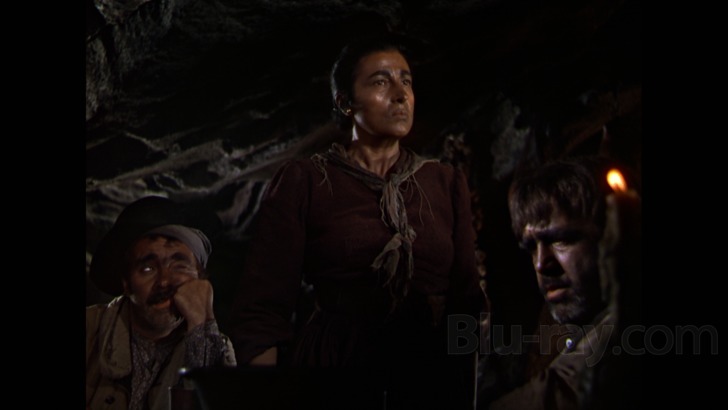
For Whom the Bell Tolls was shot in three-strip Technicolor by Ray Rennahan, who had already
received Oscars for the color photography of Gone with the
Wind and Blood and Sand.
Universal's 1080p, AVC-encoded Blu-ray appears to be derived from the same photochemical
restoration used to generate its 1998 DVD of the film, with several crucial differences.
First, as noted in the introduction, the Overture and Intermission have been dropped. As a result,
the Blu-ray is nine minutes shorter than the listed running time of 2:46. The removal of the
Intermission is especially unfortunate, because it provided an effective dramatic pause following
Pablo's apparent change of heart and his agreement to join in Jordan's effort to blow up the
bridge. (The time mark on the DVD was 1:27:44, which now corresponds to 1:24:00 on the Blu-ray.) Why Universal chose to omit these portions of
the restoration, and why the omission is not reflected in the Blu-ray's listed specifications, remains a mystery.
Second, the new master has been subjected to more intensive cleanup than the 1998 DVD. Dust
and obvious damage have been removed, along with the occasional blotches of red, green or blue
that are frequent artifacts of a three-strip Technicolor restoration (more on that in a moment).
Given Blu-ray's superior resolution and today's prevalence of bigger viewing screens in home
theaters, Universal deserves credit for making this effort, although it's far from complete.
Numerous small vertical scratches and streaks remain, though most are sufficiently faint and
brief that they will probably pass unnoticed. While the studio's cleanup work falls far
short of the standard set by Warner Archive or Criterion (when the latter is on its game), the
improvement is noteworthy.
The third notable aspect of this new presentation is the most critical and also the most technically
complicated, because it relates to the three-strip process that was one of Technicolor's earliest
techniques for color photography. Three separate strips of black-and-white film ran through the
camera simultaneously, each of them recording a different part of the spectrum: yellow, cyan and
magenta. To create interpositives or release prints, the three strips must be perfectly aligned—a
procedure that was tricky enough when the elements were new, due to minute variations in each
three-strip camera. Over time, however, as individual elements shrink, warp and otherwise shift,
perfect physical alignment is no longer possible. The result is visible fringing, where objects in
the frame are ringed with colored halos of red, blue or green. These so-called "registration"
issues could not be effectively addressed prior to the advent of sophisticated digital tools, and
they are visible throughout the 1998 DVD of Bell Tolls. For a particularly egregious example, see
the last screenshot accompanying this review, which has been taken from the DVD (screenshot
40).
For its Blu-ray of Bell Tolls, Universal has attempted to repair the worst of these issues (compare the Blu-ray's equivalent to the DVD
example, which appears just above it at screenshot 39), but it has not
undertaken the full digital overhaul that would restore the film to its original Technicolor glory.
In the digital realm, the individual layers of the three-strip process can be separated and adjusted
so that registration issues are almost entirely eliminated. Warner's MPI facility has used such a
process—they call their version "Ultra Resolution"—to restore such films as Gone with the
Wind, Kiss Me Kate and
The Band Wagon, all of which are
examples of the superb quality that
can now be achieved from three-strip sources—assuming, of course, that the studio is willing to
make the necessary investment.
But Universal took the cheap route, and while extreme instances like the scene noted above have
been toned down, Bell Tolls remains plagued by registration issues during its entire running
time. The effect is visible not only in color fringing but also in the variable sharpness, detail and
densities that can be observed throughout the film. Perhaps in an effort to conceal these shortcomings,
the image has been noticeably darkened for Blu-ray, so that the many scenes in caves lit by
firelight or outdoors at night have been markedly drained of color; indeed, some of the scenes shot
day-for-night look almost black-and-white. The impact on flesh tones is particularly unfortunate,
with Pilar and the other actors playing Spaniards often appearing as if their faces have been slathered in an artificial tan.
Cooper and Bergman, who were lit like the movie stars they were, generally retain natural
skin tones, but they are routinely surrounded by characters who look like bad oil paintings.
We can expect the familiar cries of "DNR!" when viewers see the many scenes that are soft and poorly
resolved, but in fact the film's grain field remains visible and natural. The softness is just another
manifestation of the registration issues plaguing the entire disc (and, in some shots, accentuated
by opticals).
Aside from improved cleanup, the only aspect of Universal's Blu-ray of Bell Tolls that the studio
gets right is the healthy average bitrate of 30.36 Mbps. But good compression can't do anything
to improve an inferior master.
For Whom the Bell Tolls Blu-ray Movie, Audio Quality 
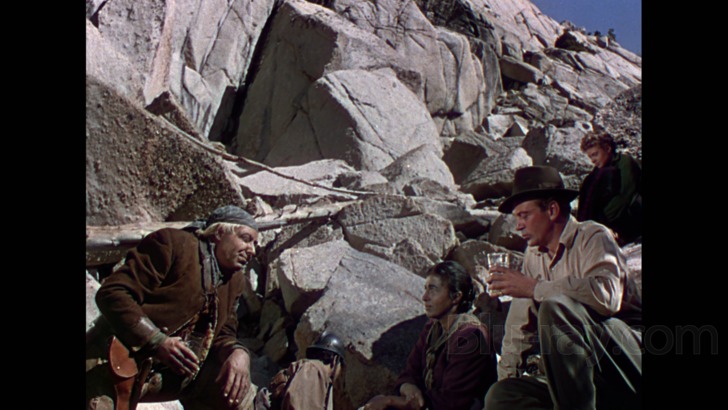
For Whom the Bell Tolls's original mono soundtrack has been encoded in lossless DTS-HD MA 2.0, and the mix is robust for its era. The dynamic range for explosions and weapons fire is relatively limited, but the impact is sufficient for the drama. Dialogue is clearly rendered, even with the variety of thick accents. The expressive orchestral score by Victor Young (Shane) is presented with as much fidelity as the recording technology of the era will allow.
For Whom the Bell Tolls Blu-ray Movie, Special Features and Extras 
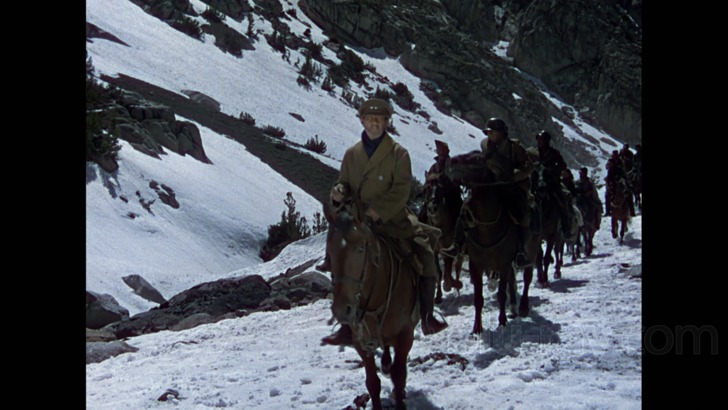
The disc has no extras. Universal's 1998 DVD had a trailer, lobby cards, production photographs and production notes, all of which have been dropped. The Blu-ray doesn't even have a menu. Insert the disc, and the film immediately begins to play. At the end, it simply stops. The presentation gives new meaning to the phrase "bare bones".
For Whom the Bell Tolls Blu-ray Movie, Overall Score and Recommendation 
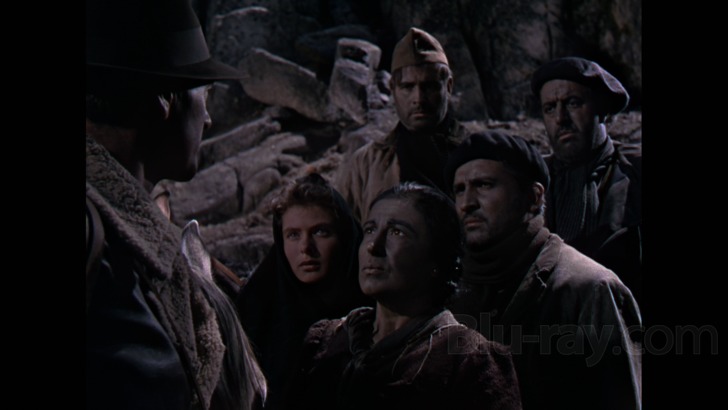
If Universal wants to emulate the Warner Archive Collection, it needs to understand that WAC's
primary focus—and the reason for its success—is the quality of its presentations. When the available
source material is inadequate, they restore it if they can, look for better materials if they cannot,
and refuse to release substandard product just because "that's the best we have". If Universal
prefers the easy route, they might as well license their existing masters to one of the specialty
houses that have created a successful niche in catalog titles by releasing them in bulk, often with
dated and inadequate transfers. At least those outfits know how to get Blu-rays pressed and out
the door. As far as For Whom the Bell Tolls is concerned, if you want to see it in its original
form, I suggest getting the DVD and upconverting it through your player or display device. The
image may not be as clean and the registration issues are sometimes extreme, but at least you'll
have the (nearly) complete restoration of the roadshow version, the DVD extras and more
balanced color. Taken as a whole, the Blu-ray is a lesser presentation and not recommended.
Other editions
For Whom the Bell Tolls: Other Editions
Similar titles
Similar titles you might also like

War and Peace
1956

In the Land of Blood and Honey
2011

A Farewell to Arms
1932

The Bitter Tea of General Yen
1933

The Best Years of Our Lives
1946

The Pride and the Passion
1957

The Four Feathers
1939

Captain Corelli's Mandolin
2001

A Farewell to Arms
1957

The Aftermath
2019

Cold Mountain
2003

Casablanca 4K
80th Anniversary Edition
1942

Wings
1927

The Captive
1915

Doctor Zhivago
45th Anniversary Edition
1965

Love and Honor
Love & Honor
2013

Ship of Fools
1965

Fire Over England
The Vivien Leigh Anniversary Collection
1937

The Pillars of the Earth
2010

The Life and Death of Colonel Blimp
1943
